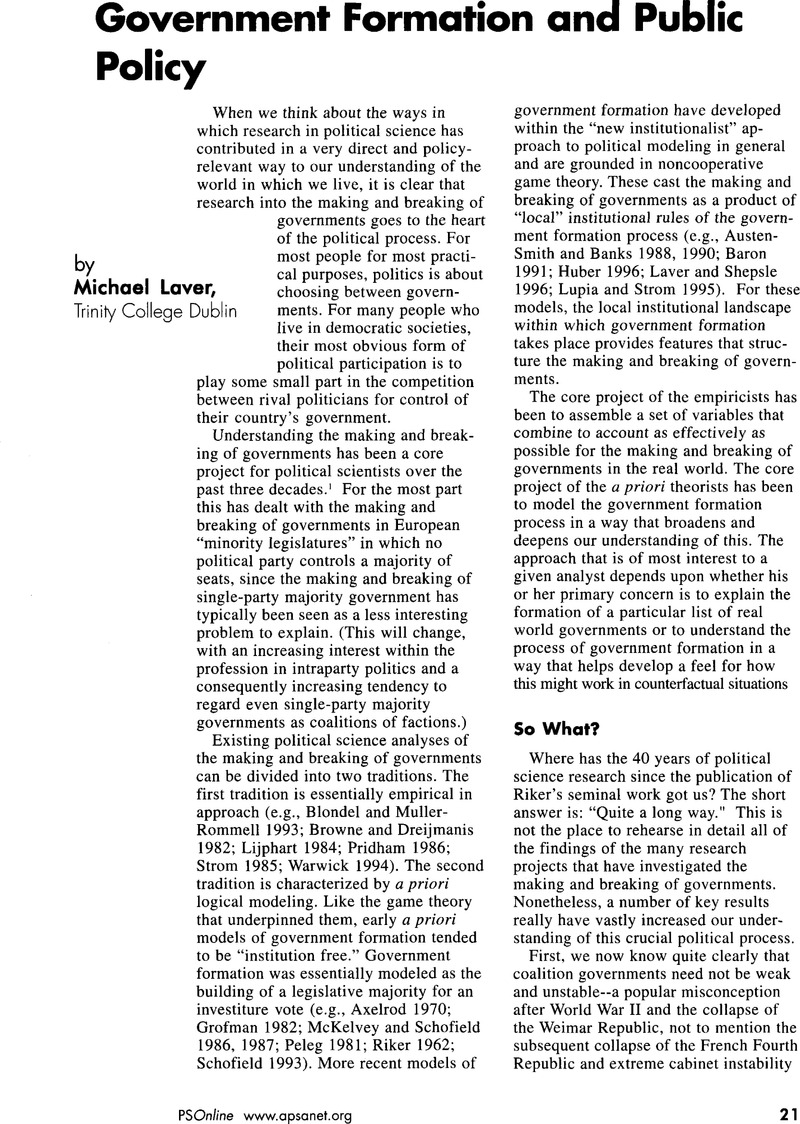No CrossRef data available.
Article contents
Government Formation and Public Policy
Published online by Cambridge University Press: 02 September 2013
Abstract
An abstract is not available for this content so a preview has been provided. Please use the Get access link above for information on how to access this content.

- Type
- The Public Value of Political Research
- Information
- PS: Political Science & Politics , Volume 33 , Special Issue 1: The Public Value of Political Science Research , March 2000 , pp. 21 - 24
- Copyright
- Copyright © The American Political Science Association 2000
References
Austen-Smith, David, and Banks, Jeffrey. 1988. “Elections, Coalitions, and Legislative Outcomes.” American Political Science Review
82(June): 405–22.CrossRefGoogle Scholar
Austen-Smith, David, and Banks, Jeffrey. 1990. “Stable Portfolio Allocations.” American Political Science Review
84(September): 891–906.CrossRefGoogle Scholar
Axelrod, Robert. 1970. Conflict of Interest: A Theory of Divergent Goals with Applications to Politics. Chicago: Markham.Google Scholar
Baron, David. 1991. “A Spatial Bargaining Theory of Government Formation in Parliamentary Systems.” American Political Science Review
85(March): 137–65.CrossRefGoogle Scholar
Blondel, Jean, and Müller-Rommel, Ferdinand, eds. 1983. Governing Together: The Extent and Limits of Joint Decision-Making in Western European Cabinets. London: Macmillan.Google Scholar
Browne, Eric C., and Dreijmanis, John, eds. 1982. Government Coalitions in Western Democracies. New York: Longman.Google Scholar
Diermeier, Daniel and Stevenson, Randy. 1999. “Cabinet Survival and Competing Risks” American Journal of Political Science
43(October): 1051–69.CrossRefGoogle Scholar
Grofman, Bernard. 1982. “A Dynamic Model of Protocoalition Formation in Ideological N-Space.” Behavioural Science
27:77–90.CrossRefGoogle Scholar
Huber, John. 1996. Rationalizing Parliament: Legislative Institutions and Party Politics in France. New York: Cambridge University Press.CrossRefGoogle Scholar
Laver, Michael. 1998. “Models of Government Formation.” Annual Review of Political Science
1:1–25.CrossRefGoogle Scholar
Laver, Michael, and Schofield, Norman. 1990. Multiparty Government: The Politics of Coalition in Europe. Oxford: Oxford University Press.Google Scholar
Laver, Michael, and Shepsle, Kenneth A.. 1996. Making and Breaking Governments. New York: Cambridge University Press.CrossRefGoogle Scholar
Lijphart, Arend. 1984. “Measures of Cabinet Durability: A Conceptual and Empirical Evaluation.” Comparative Political Studies
17:265–79.CrossRefGoogle Scholar
Lupia, Arthur, and Strom, Kaare. 1995. “Coalition Termination and the Strategic Timing of Legislative Elections.” American Political Science Review
89(September): 648–65.CrossRefGoogle Scholar
McKelvey, Richard D., and Schofield, Norman. 1986. “Structural Instability of the Core.” Journal of Mathematical Economics
15:179–98.CrossRefGoogle Scholar
McKelvey, Richard D., and Schofield, Norman. 1987. “Generalized Symmetry Conditions at a Core Point.” Econometrica
55(July): 923–33.CrossRefGoogle Scholar
Peleg, Bazalel. 1981. “Coalition Formation in Simple Games with Dominant Players.” International Journal of Game Theory
10(1): 11–13.CrossRefGoogle Scholar
Pridham, Geoffrey, ed. 1986. Coalitional Behaviour in Theory and Practice: An Inductive Model for Western Europe. Cambridge: Cambridge University Press.CrossRefGoogle Scholar
Riker, William. 1962. The Theory of Political Coalitions. New Haven: Yale University Press.Google Scholar
Schofield, Norman. 1993. “Political Competition and Multiparty Coalition Governments.” European Journal of Political Research
23(February): 1–33.CrossRefGoogle Scholar
Strom, Kaare. 1985. “Party Goals and Government Performance in Parliamentary Democracies.” American Political Science Review
79(September): 738–54.CrossRefGoogle Scholar
Strom, Kaare. 1990. Minority Government and Majority Rule. Cambridge: Cambridge University Press.Google Scholar
Warwick, Paul. 1994. Government Survival in Parliamentary Democracies. Cambridge: Cambridge University Press.Google Scholar




